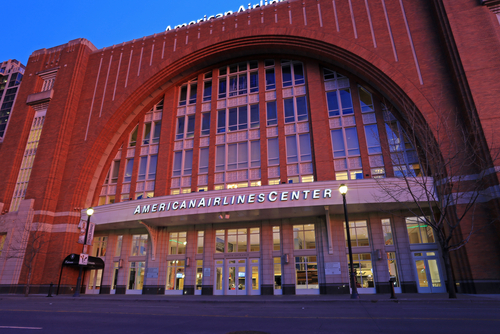American Airlines Center (AAC) in Dallas, Texas, will host the end of March Madness as the remaining four women’s basketball teams duke it out for the championship from March 31 to April 2, 2023.

Whether you’ll watch the games from a stadium seat or see all the action from the comfort of your home, you’ll likely be cheering on your favorite women’s college basketball team to be crowned 2023 basketball champion. While the players on the floor are where the action is, facilities professionals around the world will be focused on the star of the show: AAC.
What You Need to Know
- Name: American Airlines Center
- Location: Dallas, Texas
- Owner: Center Operating Company (COC)
- Cost: $420 million
- Seating capacity: 18,532 for ice hockey; 20,000 for basketball; and up to 21,000 for concerts. Additionally, there are premium seating options.
- Size (total area): 840,000 square feet (sq ft)
- Size (playing surface): 17,000 sq ft with dasher boards inserted and 19,125 sq ft with south-end seats retracted and corresponding dasher boards removed
- Concourse levels: 5
- Key building materials: More than 1,000,000 bricks and 50,000 sq ft of glass and glazing were utilized in construction. 250+ lights were also installed in the ceiling with Kevlar shutters to dim or shut off natural light.
- Notable feature: Retractable seating to convert the facility from a basketball court to an ice hockey rink
- Year opened: 2001 (broke ground in 1999)
- Renovations: 2009, 2014, 2017, and 2022
- Planned renovations: Summer 2023: scoreboard upgrades, bowl seat upgrades, and suite seat upgrades
- Primary uses: NBA’s Dallas Mavericks and NHL’s Dallas Stars (both 2001 to present)
- Other uses: Annual home to the Harlem Globetrotters, Disney on Ice, World Wrestling Entertainment, and the Trans-Siberian Orchestra Holiday Show. Other live concerts also take place.
What’s in a Name?
AAC was named after the airline American Airlines (AA), which acquired naming rights for $195 million in 1999, when AAC was under construction. AA is headquartered in nearby Fort Worth and based at Dallas/Fort Worth International Airport, 2021’s second busiest airport in the world.
A Very Expensive Arena
Called “the nation’s most expensive arena” when it opened in July 2001, AAC’s original project cost of $230 million nearly doubled to $420 million. This hefty increase made sure the facility was fully accessible to the disabled, incorporated new technologies, provided better acoustics, featured more food concessions, increased seating capacity, and provided more restrooms than what was originally envisioned.
In fact, AAC was the largest arena by square feet in the United States when it opened.
Tom Hicks, owner of the Dallas Stars, told The Dallas Morning News that “we decided to build a world-class facility that would be the appropriate showcase for our two teams.”
What Does It Look Like?

From afar, the center has an identifiable double-barrel, vaulted, 4-acre structural steel roof that can be seen from nearby freeways and high-rise office buildings.
The inside has a lightweight prefabricated structure of galvanized steel with a semi-cylindrical cross-section that looks like a hangar.
According to international design firm HKS, which designed AAC, the facility has special components. “The interior of the structure competes with music halls or museums with terrazzo floors that incorporate artist panels, natural light through the four main entry lobbies, and a five-level seating bowl with unique features at each end that generate revenue,” referring to various unique food, beverage, and retail outlets.
Unique Seating

Lobbies also provide access to 40,776 sq ft of meeting space in addition to providing access to seating areas.
Retractable seating transforms a 20,000-seat basketball arena into an 18,532-seat ice hockey rink in 2 hours or less. The rink requires 8 miles of 1-inch pipe underneath the ice, and 10,000 gallons of water are needed for 1 sheet of ice.
With standing room, 21,146 can be accommodated for basketball games and 19,323 for ice hockey games. For concerts, the capacity is approximately 21,000.

Video Upgrades
In 2009, AAC became home to the first 1080 x 1920 high-definition video screen in an NBA or NHL facility as part of a significant video upgrade that included 25 LED screens.
The upgrades also included new screens for the center-hung display along with video screens at each end of the arena that were three times larger than the previous ones.
Locker Room and Office Renovation
A major renovation came to the Mavericks’ locker rooms, showers, restrooms, weight room, offices, and training pools in 2017—the first upgrade to those areas.
Mavericks Owner Mark Cuban says, “We brought in experts from the casino industry to integrate lighting that stimulates energy and a complete renovation of our ventilation system so we could integrate oxygen and more into the air we deliver into the locker room.”
SB Nation notes each locker has a tablet, a refrigerated cup holder, a flat-screen TV, and ventilated drawers.
But perhaps the most out-of-the-box feature is facial recognition, which allows cameras to scan everyone who walks in, puts each individual’s face up on a screen near the entrance, and then displays information pertinent to that individual, such as schedules, workout info., etc.
New Roof
WFAA-TV reports that during summer 2022, $7 million of improvements were made to the facility, including 5G wireless Internet access; new equipment; and, most notably, a new roof to replace the old one, which leaked twice during the NHL 2021–22 season, including during a playoff game.
The new roof, installed by KPost Roofing and Waterproofing, used Soperma products delivered to AAC via helicopter, including 661 pails of bonding adhesive; 309 rolls of 8-mil P200 (PVC roof membrane); 8,500 pieces of insulation; and almost 7,000 kilograms of Alsan RS products to aid in detail and flashing work.
While there were plans to replace the roof in 2020, the pandemic delayed them; they were delayed yet again in 2021 when the Mavericks went to the playoffs.
Sustainability
A 2021 press release states that AAC achieved Global Biorisk Advisory Council (GBAC) STAR accreditation. GBAC, a Division of the International Sanitary Supply Association (ISSA), a worldwide cleaning association, recognizes the facility for its stringent protocols for cleaning, disinfection, and infectious disease prevention.
“GBAC STAR accreditation empowers facility owners and managers to assure workers, customers, and key stakeholders that they have proven systems in place to maintain clean and healthy environments,” according to GBAC Executive Director Patricia Olinger. “By taking this important step to pursue GBAC STAR, American Airlines Center has received third-party validation that it follows strict protocols for bio risk situations, thereby demonstrating its preparedness and commitment to operating safely.”
Security
While the facility originally had an analog surveillance camera system, it failed over time. According to a case study by Axis Communications, Mose Boyer, director of operations for AAC, says, “Once we decided to replace our failing analog system, we invited most of the major camera manufacturers to showcase their products in the building so we could see how they perform.”
This led the facility to adopt an advanced, high-definition, network-based video camera system from Axis in 2020. This included 228 network cameras in a variety of areas, such as seating, concourses, lobby areas, retail areas, and the rooftop. These cameras can pan, tilt, zoom; have a wide dynamic range and a wide-angle field of view; and are infrared. In addition, the facility security operations center has a bank of six 55-inch HD 1080p TV monitors that allow staff to view cameras live and maintain recorded video, which is stored on four 20-terabyte servers and archived for up to 30 days.
Boyer notes, “Our security team is catching incidents they never could have with our old analog cameras.”
Notable Awards and Recognition
According to HKS, the center has received the following awards:
- In 2015, it was named the fifth-busiest arena in the United States and the 10th busiest in the world, according to Billboard Magazine.
- 2007 Top 150 America’s Favorite Architecture (AIA).
- 2003 Design Award of Merit (Society of American Registered Architects).
- 2002 Engineering Excellence Award (American Council of Engineering Companies).
- 2002 Facility of Merit (Athletic Business Magazine).
- 2002 Minority Business Development Agency Outstanding Corporate Award (U.S. Department of Commerce).
- 2001 Best New Major Venue Award (Concert Industry Consortium).
Planning for the Future
Although his team’s lease isn’t up until July 2031, Cuban has indicated the Mavericks are looking to build a new arena elsewhere within the city, but Dallas Stars CEO Brad Alberts says he’d prefer that his hockey team stay at AAC.
Alberts hopes AAC can be renovated to make it last another 25 years and indicates that could include new clubs, concessions, and technology. He is also hopeful the state will legalize sports betting, which could help generate needed revenue for renovations that are estimated to cost between $200 million and $500 million.
“Depending on what you do and the level you do it at, you can almost create the feeling of a brand new experience when you get it done,” Alberts says.
A Facility That’s a Slam Dunk

While the stadium went over its original budget, it features a state-of-the-art surveillance system and retractable seating to accommodate NBA and NHL needs, received numerous awards, and has embraced technology. It also first held women’s basketball tournament finals in 2017, when the South Carolina Gamecocks defeated the Mississippi State Bulldogs 67–55.
Additional information and details on AAC, including interactive concourse maps showing seating, restaurants, restrooms, and elevators, can be found by clicking here.
ALSO READ: NRG Stadium: Star Player for Men’s March Madness Final Four
